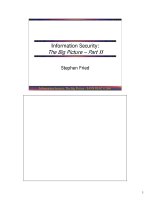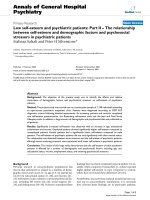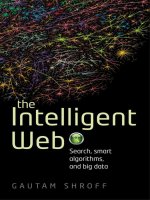Web and big data part II 2018
Bạn đang xem bản rút gọn của tài liệu. Xem và tải ngay bản đầy đủ của tài liệu tại đây (30.89 MB, 481 trang )
LNCS 10988
Yi Cai
Yoshiharu Ishikawa
Jianliang Xu (Eds.)
Web and Big Data
Second International Joint Conference, APWeb-WAIM 2018
Macau, China, July 23–25, 2018
Proceedings, Part II
123
Lecture Notes in Computer Science
Commenced Publication in 1973
Founding and Former Series Editors:
Gerhard Goos, Juris Hartmanis, and Jan van Leeuwen
Editorial Board
David Hutchison
Lancaster University, Lancaster, UK
Takeo Kanade
Carnegie Mellon University, Pittsburgh, PA, USA
Josef Kittler
University of Surrey, Guildford, UK
Jon M. Kleinberg
Cornell University, Ithaca, NY, USA
Friedemann Mattern
ETH Zurich, Zurich, Switzerland
John C. Mitchell
Stanford University, Stanford, CA, USA
Moni Naor
Weizmann Institute of Science, Rehovot, Israel
C. Pandu Rangan
Indian Institute of Technology Madras, Chennai, India
Bernhard Steffen
TU Dortmund University, Dortmund, Germany
Demetri Terzopoulos
University of California, Los Angeles, CA, USA
Doug Tygar
University of California, Berkeley, CA, USA
Gerhard Weikum
Max Planck Institute for Informatics, Saarbrücken, Germany
10988
More information about this series at />
Yi Cai Yoshiharu Ishikawa
Jianliang Xu (Eds.)
•
Web and Big Data
Second International Joint Conference, APWeb-WAIM 2018
Macau, China, July 23–25, 2018
Proceedings, Part II
123
Editors
Yi Cai
South China University of Technology
Guangzhou
China
Jianliang Xu
Hong Kong Baptist University
Kowloon Tong, Hong Kong
China
Yoshiharu Ishikawa
Nagoya University
Nagoya
Japan
ISSN 0302-9743
ISSN 1611-3349 (electronic)
Lecture Notes in Computer Science
ISBN 978-3-319-96892-6
ISBN 978-3-319-96893-3 (eBook)
/>Library of Congress Control Number: 2018948814
LNCS Sublibrary: SL3 – Information Systems and Applications, incl. Internet/Web, and HCI
© Springer International Publishing AG, part of Springer Nature 2018
This work is subject to copyright. All rights are reserved by the Publisher, whether the whole or part of the
material is concerned, specifically the rights of translation, reprinting, reuse of illustrations, recitation,
broadcasting, reproduction on microfilms or in any other physical way, and transmission or information
storage and retrieval, electronic adaptation, computer software, or by similar or dissimilar methodology now
known or hereafter developed.
The use of general descriptive names, registered names, trademarks, service marks, etc. in this publication
does not imply, even in the absence of a specific statement, that such names are exempt from the relevant
protective laws and regulations and therefore free for general use.
The publisher, the authors and the editors are safe to assume that the advice and information in this book are
believed to be true and accurate at the date of publication. Neither the publisher nor the authors or the editors
give a warranty, express or implied, with respect to the material contained herein or for any errors or
omissions that may have been made. The publisher remains neutral with regard to jurisdictional claims in
published maps and institutional affiliations.
This Springer imprint is published by the registered company Springer Nature Switzerland AG
The registered company address is: Gewerbestrasse 11, 6330 Cham, Switzerland
Preface
This volume (LNCS 10987) and its companion volume (LNCS 10988) contain the
proceedings of the second Asia-Pacific Web (APWeb) and Web-Age Information
Management (WAIM) Joint Conference on Web and Big Data, called APWeb-WAIM.
This joint conference aims to attract participants from different scientific communities
as well as from industry, and not merely from the Asia Pacific region, but also from
other continents. The objective is to enable the sharing and exchange of ideas, experiences, and results in the areas of World Wide Web and big data, thus covering Web
technologies, database systems, information management, software engineering, and
big data. The second APWeb-WAIM conference was held in Macau during July
23–25, 2018. As an Asia-Pacific flagship conference focusing on research, development, and applications in relation to Web information management, APWeb-WAIM
builds on the successes of APWeb and WAIM: APWeb was previously held in Beijing
(1998), Hong Kong (1999), Xi’an (2000), Changsha (2001), Xi’an (2003), Hangzhou
(2004), Shanghai (2005), Harbin (2006), Huangshan (2007), Shenyang (2008), Suzhou
(2009), Busan (2010), Beijing (2011), Kunming (2012), Sydney (2013), Changsha
(2014), Guangzhou (2015), and Suzhou (2016); and WAIM was held in Shanghai
(2000), Xi’an (2001), Beijing (2002), Chengdu (2003), Dalian (2004), Hangzhou
(2005), Hong Kong (2006), Huangshan (2007), Zhangjiajie (2008), Suzhou (2009),
Jiuzhaigou (2010), Wuhan (2011), Harbin (2012), Beidaihe (2013), Macau (2014),
Qingdao (2015), and Nanchang (2016). The first joint APWeb-WAIM conference was
held in Bejing (2017). With the fast development of Web-related technologies, we
expect that APWeb-WAIM will become an increasingly popular forum that brings
together outstanding researchers and developers in the field of the Web and big data
from around the world. The high-quality program documented in these proceedings
would not have been possible without the authors who chose APWeb-WAIM for
disseminating their findings. Out of 168 submissions, the conference accepted 39
regular (23.21%), 31 short research papers, and six demonstrations. The contributed
papers address a wide range of topics, such as text analysis, graph data processing,
social networks, recommender systems, information retrieval, data streams, knowledge
graph, data mining and application, query processing, machine learning, database and
Web applications, big data, and blockchain. The technical program also included
keynotes by Prof. Xuemin Lin (The University of New South Wales, Australia),
Prof. Lei Chen (The Hong Kong University of Science and Technology, Hong Kong,
SAR China), and Prof. Ninghui Li (Purdue University, USA) as well as industrial
invited talks by Dr. Zhao Cao (Huawei Blockchain) and Jun Yan (YiDu Cloud). We
are grateful to these distinguished scientists for their invaluable contributions to the
conference program. As a joint conference, teamwork was particularly important for
the success of APWeb-WAIM. We are deeply thankful to the Program Committee
members and the external reviewers for lending their time and expertise to the conference. Special thanks go to the local Organizing Committee led by Prof. Zhiguo Gong.
VI
Preface
Thanks also go to the workshop co-chairs (Leong Hou U and Haoran Xie), demo
co-chairs (Zhixu Li, Zhifeng Bao, and Lisi Chen), industry co-chair (Wenyin Liu), tutorial
co-chair (Jian Yang), panel chair (Kamal Karlapalem), local arrangements chair
(Derek Fai Wong), and publicity co-chairs (An Liu, Feifei Li, Wen-Chih Peng, and
Ladjel Bellatreche). Their efforts were essential to the success of the conference. Last
but not least, we wish to express our gratitude to the treasurer (Andrew Shibo Jiang),
the Webmaster (William Sio) for all the hard work, and to our sponsors who generously
supported the smooth running of the conference. We hope you enjoy the exciting
program of APWeb-WAIM 2018 as documented in these proceedings.
June 2018
Yi Cai
Jianliang Xu
Yoshiharu Ishikawa
Organization
Organizing Committee
Honorary Chair
Lionel Ni
University of Macau, SAR China
General Co-chairs
Zhiguo Gong
Qing Li
Kam-fai Wong
University of Macau, SAR China
City University of Hong Kong, SAR China
Chinese University of Hong Kong, SAR China
Program Co-chairs
Yi Cai
Yoshiharu Ishikawa
Jianliang Xu
South China University of Technology, China
Nagoya University, Japan
Hong Kong Baptist University, SAR China
Workshop Chairs
Leong Hou U
Haoran Xie
University of Macau, SAR China
Education University of Hong Kong, SAR China
Demo Co-chairs
Zhixu Li
Zhifeng Bao
Lisi Chen
Soochow University, China
RMIT, Australia
Wollongong University, Australia
Tutorial Chair
Jian Yang
Macquarie University, Australia
Industry Chair
Wenyin Liu
Guangdong University of Technology, China
Panel Chair
Kamal Karlapalem
IIIT, Hyderabad, India
Publicity Co-chairs
An Liu
Feifei Li
Soochow University, China
University of Utah, USA
VIII
Organization
Wen-Chih Peng
Ladjel Bellatreche
National Taiwan University, China
ISAE-ENSMA, Poitiers, France
Treasurers
Leong Hou U
Andrew Shibo Jiang
University of Macau, SAR China
Macau Convention and Exhibition Association,
SAR China
Local Arrangements Chair
Derek Fai Wong
University of Macau, SAR China
Webmaster
William Sio
University of Macau, SAR China
Senior Program Committee
Bin Cui
Byron Choi
Christian Jensen
Demetrios
Zeinalipour-Yazti
Feifei Li
Guoliang Li
K. Selçuk Candan
Kyuseok Shim
Makoto Onizuka
Reynold Cheng
Toshiyuki Amagasa
Walid Aref
Wang-Chien Lee
Wen-Chih Peng
Wook-Shin Han Pohang
Xiaokui Xiao
Ying Zhang
Peking University, China
Hong Kong Baptist University, SAR China
Aalborg University, Denmark
University of Cyprus, Cyprus
University of Utah, USA
Tsinghua University, China
Arizona State University, USA
Seoul National University, South Korea
Osaka University, Japan
The University of Hong Kong, SAR China
University of Tsukuba, Japan
Purdue University, USA
Pennsylvania State University, USA
National Chiao Tung University, Taiwan
University of Science and Technology, South Korea
National University of Singapore, Singapore
University of Technology Sydney, Australia
Program Committee
Alex Thomo
An Liu
Baoning Niu
Bin Yang
Bo Tang
Zouhaier Brahmia
Carson Leung
Cheng Long
University of Victoria, Canada
Soochow University, China
Taiyuan University of Technology, China
Aalborg University, Denmark
Southern University of Science and Technology, China
University of Sfax, Tunisia
University of Manitoba, Canada
Queen’s University Belfast, UK
Organization
Chih-Chien Hung
Chih-Hua Tai
Cuiping Li
Daniele Riboni
Defu Lian
Dejing Dou
Dimitris Sacharidis
Ganzhao Yuan
Giovanna Guerrini
Guanfeng Liu
Guoqiong Liao
Guanling Lee
Haibo Hu
Hailong Sun
Han Su
Haoran Xie
Hiroaki Ohshima
Hong Chen
Hongyan Liu
Hongzhi Wang
Hongzhi Yin
Hua Wang
Ilaria Bartolini
James Cheng
Jeffrey Xu Yu
Jiajun Liu
Jialong Han
Jianbin Huang
Jian Yin
Jiannan Wang
Jianting Zhang
Jianxin Li
Jianzhong Qi
Jinchuan Chen
Ju Fan
Jun Gao
Junhu Wang
Kai Zeng
Kai Zheng
Karine Zeitouni
Lei Zou
Leong Hou U
Liang Hong
Lianghuai Yang
IX
Tamkang University, China
National Taipei University, China
Renmin University of China, China
University of Cagliari, Italy
Big Data Research Center, University of Electronic
Science and Technology of China, China
University of Oregon, USA
Technische Universität Wien, Austria
Sun Yat-sen University, China
Università di Genova, Italy
The University of Queensland, Australia
Jiangxi University of Finance and Economics, China
National Dong Hwa University, China
Hong Kong Polytechnic University, SAR China
Beihang University, China
University of Southern California, USA
The Education University of Hong Kong, SAR China
University of Hyogo, Japan
Renmin University of China, China
Tsinghua University, China
Harbin Institute of Technology, China
The University of Queensland, Australia
Victoria University, Australia
University of Bologna, Italy
Chinese University of Hong Kong, SAR China
Chinese University of Hong Kong, SAR China
Renmin University of China, China
Nanyang Technological University, Singapore
Xidian University, China
Sun Yat-sen University, China
Simon Fraser University, Canada
City College of New York, USA
Beihang University, China
University of Melbourne, Australia
Renmin University of China, China
Renmin University of China, China
Peking University, China
Griffith University, Australia
Microsoft, USA
University of Electronic Science and Technology
of China, China
Université de Versailles Saint-Quentin, France
Peking University, China
University of Macau, SAR China
Wuhan University, China
Zhejiang University of Technology, China
X
Organization
Lisi Chen
Lu Chen
Maria Damiani
Markus Endres
Mihai Lupu
Mirco Nanni
Mizuho Iwaihara
Peiquan Jin
Peng Wang
Qin Lu
Ralf Hartmut Güting
Raymond Chi-Wing Wong
Ronghua Li
Rui Zhang
Sanghyun Park
Sanjay Madria
Shaoxu Song
Shengli Wu
Shimin Chen
Shuai Ma
Shuo Shang
Takahiro Hara
Tieyun Qian
Tingjian Ge
Tom Z. J. Fu
Tru Cao
Vincent Oria
Wee Ng
Wei Wang
Weining Qian
Weiwei Sun
Wen Zhang
Wolf-Tilo Balke
Wookey Lee
Xiang Zhao
Xiang Lian
Xiangliang Zhang
Xiangmin Zhou
Xiaochun Yang
Xiaofeng He
Xiaohui (Daniel) Tao
Xiaoyong Du
Xike Xie
Wollongong University, Australia
Aalborg University, Denmark
University of Milan, Italy
University of Augsburg, Germany
Vienna University of Technology, Austria
ISTI-CNR Pisa, Italy
Waseda University, Japan
University of Science and Technology of China, China
Fudan University, China
University of Technology Sydney, Australia
Fernuniversität in Hagen, Germany
Hong Kong University of Science and Technology,
SAR China
Shenzhen University, China
University of Melbourne, Australia
Yonsei University, South Korea
Missouri University of Science and Technology, USA
Tsinghua University, China
Jiangsu University, China
Chinese Academy of Sciences, China
Beihang University, China
King Abdullah University of Science and Technology,
Saudi Arabia
Osaka University, Japan
Wuhan University, China
University of Massachusetts, Lowell, USA
Advanced Digital Sciences Center, Singapore
Ho Chi Minh City University of Technology, Vietnam
New Jersey Institute of Technology, USA
Institute for Infocomm Research, Singapore
University of New South wales, Australia
East China Normal University, China
Fudan University, China
Wuhan University, China
Technische Universität Braunschweig, Germany
Inha University, South Korea
National University of Defence Technology, China
Kent State University, USA
King Abdullah University of Science and Technology,
Saudi Arabia
RMIT University, Australia
Northeast University, China
East China Normal University, China
The University of Southern Queensland, Australia
Renmin University of China, China
University of Science and Technology of China, China
Organization
Xin Cao
Xin Huang
Xin Wang
Xingquan Zhu
Xuan Zhou
Yafei Li
Yanghua Xiao
Yanghui Rao
Yang-Sae Moon
Yaokai Feng
Yi Cai
Yijie Wang
Yingxia Shao
Yongxin Tong
Yu Gu
Yuan Fang
Yunjun Gao
Zakaria Maamar
Zhaonian Zou
Zhiwei Zhang
The University of New South Wales, Australia
Hong Kong Baptist University, SAR China
Tianjin University, China
Florida Atlantic University, USA
Renmin University of China, China
Zhengzhou University, China
Fudan University, China
Sun Yat-sen University, China
Kangwon National University, South Korea
Kyushu University, Japan
South China University of Technology, China
National University of Defense Technology, China
Peking University, China
Beihang University, China
Northeastern University, China
Institute for Infocomm Research, Singapore
Zhejiang University, China
Zayed University, United Arab of Emirates
Harbin Institute of Technology, China
Hong Kong Baptist University, SAR China
XI
Keynotes
Graph Processing: Applications, Challenges,
and Advances
Xuemin Lin
School of Computer Science and Engineering,
University of New South Wales, Sydney
Abstract. Graph data are key parts of Big Data and widely used for modelling
complex structured data with a broad spectrum of applications. Over the last
decade, tremendous research efforts have been devoted to many fundamental
problems in managing and analyzing graph data. In this talk, I will cover various
applications, challenges, and recent advances. We will also look to the future
of the area.
Differential Privacy in the Local Setting
Ninghui Li
Department of Computer Sciences, Purdue University
Abstract. Differential privacy has been increasingly accepted as the de facto
standard for data privacy in the research community. Recently, techniques for
satisfying differential privacy (DP) in the local setting, which we call LDP, have
been deployed. Such techniques enable the gathering of statistics while preserving privacy of every user, without relying on trust in a single data curator.
Companies such as Google, Apple, and Microsoft have deployed techniques for
collecting user data while satisfying LDP. In this talk, we will discuss the state
of the art of LDP. We survey recent developments for LDP, and discuss protocols for estimating frequencies of different values under LDP, and for computing marginal when each user has multiple attributes. Finally, we discuss
limitations and open problems of LDP.
Big Data, AI, and HI, What is the Next?
Lei Chen
Department of Computer Science and Engineering, Hong Kong University
of Science and Technology
Abstract. Recently, AI has become quite popular and attractive, not only to the
academia but also to the industry. The successful stories of AI on Alpha-go and
Texas hold ’em games raise significant public interests on AI. Meanwhile,
human intelligence is turning out to be more sophisticated, and Big Data
technology is everywhere to improve our life quality. The question we all want
to ask is “what is the next?”. In this talk, I will discuss about DHA, a new
computing paradigm, which combines big Data, Human intelligence, and AI.
First I will briefly explain the motivation of DHA. Then I will present some
challenges and possible solutions to build this new paradigm.
Contents – Part II
Database and Web Applications
Fuzzy Searching Encryption with Complex Wild-Cards Queries
on Encrypted Database . . . . . . . . . . . . . . . . . . . . . . . . . . . . . . . . . . . . . .
He Chen, Xiuxia Tian, and Cheqing Jin
Towards Privacy-Preserving Travel-Time-First Task Assignment
in Spatial Crowdsourcing . . . . . . . . . . . . . . . . . . . . . . . . . . . . . . . . . . . . .
Jian Li, An Liu, Weiqi Wang, Zhixu Li, Guanfeng Liu, Lei Zhao,
and Kai Zheng
3
19
Plover: Parallel In-Memory Database Logging on Scalable Storage Devices . . .
Huan Zhou, Jinwei Guo, Ouya Pei, Weining Qian, Xuan Zhou,
and Aoying Zhou
35
Inferring Regular Expressions with Interleaving from XML Data . . . . . . . . .
Xiaolan Zhang, Yeting Li, Fei Tian, Fanlin Cui, Chunmei Dong,
and Haiming Chen
44
Efficient Query Reverse Engineering for Joins
and OLAP-Style Aggregations . . . . . . . . . . . . . . . . . . . . . . . . . . . . . . . . .
Wei Chit Tan
53
DCA: The Advanced Privacy-Enhancing Schemes
for Location-Based Services . . . . . . . . . . . . . . . . . . . . . . . . . . . . . . . . . . .
Jiaxun Hua, Yu Liu, Yibin Shen, Xiuxia Tian, and Cheqing Jin
63
Data Streams
Discussion on Fast and Accurate Sketches for Skewed Data Streams:
A Case Study . . . . . . . . . . . . . . . . . . . . . . . . . . . . . . . . . . . . . . . . . . . . .
Shuhao Sun and Dagang Li
Matching Consecutive Subpatterns over Streaming Time Series . . . . . . . . . .
Rong Kang, Chen Wang, Peng Wang, Yuting Ding, and Jianmin Wang
A Data Services Composition Approach for Continuous Query
on Data Streams . . . . . . . . . . . . . . . . . . . . . . . . . . . . . . . . . . . . . . . . . . .
Guiling Wang, Xiaojiang Zuo, Marc Hesenius, Yao Xu, Yanbo Han,
and Volker Gruhn
75
90
106
XX
Contents – Part II
Discovering Multiple Time Lags of Temporal Dependencies from
Fluctuating Events. . . . . . . . . . . . . . . . . . . . . . . . . . . . . . . . . . . . . . . . . .
Wentao Wang, Chunqiu Zeng, and Tao Li
A Combined Model for Time Series Prediction in Financial Markets . . . . . . .
Hongbo Sun, Chenkai Guo, Jing Xu, Jingwen Zhu, and Chao Zhang
121
138
Data Mining and Application
Location Prediction in Social Networks . . . . . . . . . . . . . . . . . . . . . . . . . . .
Rong Liu, Guanglin Cong, Bolong Zheng, Kai Zheng, and Han Su
151
Efficient Longest Streak Discovery in Multidimensional Sequence Data . . . . .
Wentao Wang, Bo Tang, and Min Zhu
166
Map Matching Algorithms: An Experimental Evaluation . . . . . . . . . . . . . . .
Na Ta, Jiuqi Wang, and Guoliang Li
182
Predicting Passenger’s Public Transportation Travel Route Using Smart
Card Data . . . . . . . . . . . . . . . . . . . . . . . . . . . . . . . . . . . . . . . . . . . . . . .
Chen Yang, Wei Chen, Bolong Zheng, Tieke He, Kai Zheng, and Han Su
199
Detecting Taxi Speeding from Sparse and Low-Sampled Trajectory Data . . . .
Xibo Zhou, Qiong Luo, Dian Zhang, and Lionel M. Ni
214
Cloned Vehicle Behavior Analysis Framework . . . . . . . . . . . . . . . . . . . . . .
Minxi Li, Jiali Mao, Xiaodong Qi, Peisen Yuan, and Cheqing Jin
223
An Event Correlation Based Approach to Predictive Maintenance . . . . . . . . .
Meiling Zhu, Chen Liu, and Yanbo Han
232
Using Crowdsourcing for Fine-Grained Entity Type Completion in
Knowledge Bases . . . . . . . . . . . . . . . . . . . . . . . . . . . . . . . . . . . . . . . . . .
Zhaoan Dong, Ju Fan, Jiaheng Lu, Xiaoyong Du, and Tok Wang Ling
248
Improving Clinical Named Entity Recognition with Global
Neural Attention . . . . . . . . . . . . . . . . . . . . . . . . . . . . . . . . . . . . . . . . . . .
Guohai Xu, Chengyu Wang, and Xiaofeng He
264
Exploiting Implicit Social Relationship for Point-of-Interest
Recommendation . . . . . . . . . . . . . . . . . . . . . . . . . . . . . . . . . . . . . . . . . .
Haifeng Zhu, Pengpeng Zhao, Zhixu Li, Jiajie Xu, Lei Zhao,
and Victor S. Sheng
Spatial Co-location Pattern Mining Based on Density Peaks Clustering
and Fuzzy Theory . . . . . . . . . . . . . . . . . . . . . . . . . . . . . . . . . . . . . . . . . .
Yuan Fang, Lizhen Wang, and Teng Hu
280
298
Contents – Part II
A Tensor-Based Method for Geosensor Data Forecasting . . . . . . . . . . . . . . .
Lihua Zhou, Guowang Du, Qing Xiao, and Lizhen Wang
XXI
306
Query Processing
Aggregate k Nearest Neighbor Queries in Metric Spaces . . . . . . . . . . . . . . .
Xin Ding, Yuanliang Zhang, Lu Chen, Keyu Yang, and Yunjun Gao
317
Finding the K Nearest Objects over Time Dependent Road Networks . . . . . .
Muxi Leng, Yajun Yang, Junhu Wang, Qinghua Hu, and Xin Wang
334
Reverse Top-k Query on Uncertain Preference . . . . . . . . . . . . . . . . . . . . . .
Guohui Li, Qi Chen, Bolong Zheng, and Xiaosong Zhao
350
Keyphrase Extraction Based on Optimized Random Walks
on Multiple Word Relations . . . . . . . . . . . . . . . . . . . . . . . . . . . . . . . . . . .
Wenyan Chen, Zheng Liu, Wei Shi, and Jeffrey Xu Yu
Answering Range-Based Reverse kNN Queries . . . . . . . . . . . . . . . . . . . . . .
Zhefan Zhong, Xin Lin, Liang He, and Yan Yang
359
368
Big Data and Blockchain
EarnCache: Self-adaptive Incremental Caching for Big Data Applications . . .
Yifeng Luo, Junshi Guo, and Shuigeng Zhou
379
Storage and Recreation Trade-Off for Multi-version Data Management . . . . .
Yin Zhang, Huiping Liu, Cheqing Jin, and Ye Guo
394
Decentralized Data Integrity Verification Model in Untrusted Environment. . .
Kun Hao, Junchang Xin, Zhiqiong Wang, Zhuochen Jiang,
and Guoren Wang
410
Enabling Concurrency on Smart Contracts Using Multiversion Ordering . . . .
An Zhang and Kunlong Zhang
425
ElasticChain: Support Very Large Blockchain by Reducing
Data Redundancy . . . . . . . . . . . . . . . . . . . . . . . . . . . . . . . . . . . . . . . . . .
Dayu Jia, Junchang Xin, Zhiqiong Wang, Wei Guo, and Guoren Wang
440
A MapReduce-Based Approach for Mining Embedded Patterns
from Large Tree Data . . . . . . . . . . . . . . . . . . . . . . . . . . . . . . . . . . . . . . .
Wen Zhao and Xiaoying Wu
455
Author Index . . . . . . . . . . . . . . . . . . . . . . . . . . . . . . . . . . . . . . . . . . . .
463
Contents – Part I
Text Analysis
Abstractive Summarization with the Aid of Extractive Summarization . . . . . .
Yangbin Chen, Yun Ma, Xudong Mao, and Qing Li
3
Rank-Integrated Topic Modeling: A General Framework . . . . . . . . . . . . . . .
Zhen Zhang, Ruixuan Li, Yuhua Li, and Xiwu Gu
16
Multi-label Classification via Label-Topic Pairs . . . . . . . . . . . . . . . . . . . . .
Gang Chen, Yue Peng, and Chongjun Wang
32
Similarity Calculations of Academic Articles Using Topic Events
and Domain Knowledge. . . . . . . . . . . . . . . . . . . . . . . . . . . . . . . . . . . . . .
Ming Liu, Bo Lang, and Zepeng Gu
Sentiment Classification via Supplementary Information Modeling . . . . . . . .
Zenan Xu, Yetao Fu, Xingming Chen, Yanghui Rao, Haoran Xie,
Fu Lee Wang, and Yang Peng
Training Set Similarity Based Parameter Selection for Statistical
Machine Translation . . . . . . . . . . . . . . . . . . . . . . . . . . . . . . . . . . . . . . . .
Xuewen Shi, Heyan Huang, Ping Jian, and Yi-Kun Tang
45
54
63
Social Networks
Identifying Scholarly Communities from Unstructured Texts . . . . . . . . . . . .
Ming Liu, Yang Chen, Bo Lang, Li Zhang, and Hongting Niu
75
A Hybrid Spectral Method for Network Community Detection . . . . . . . . . . .
Jianjun Cheng, Longjie Li, Haijuan Yang, Qi Li, and Xiaoyun Chen
90
Personalized Top-n Influential Community Search over Large
Social Networks . . . . . . . . . . . . . . . . . . . . . . . . . . . . . . . . . . . . . . . . . . .
Jian Xu, Xiaoyi Fu, Liming Tu, Ming Luo, Ming Xu, and Ning Zheng
105
Matrix Factorization Meets Social Network Embedding for Rating
Prediction. . . . . . . . . . . . . . . . . . . . . . . . . . . . . . . . . . . . . . . . . . . . . . . .
Menghao Zhang, Binbin Hu, Chuan Shi, Bin Wu, and Bai Wang
121
An Estimation Framework of Node Contribution Based
on Diffusion Information . . . . . . . . . . . . . . . . . . . . . . . . . . . . . . . . . . . . .
Zhijian Zhang, Ling Liu, Kun Yue, and Weiyi Liu
130
XXIV
Contents – Part I
Multivariate Time Series Clustering via Multi-relational Community
Detection in Networks . . . . . . . . . . . . . . . . . . . . . . . . . . . . . . . . . . . . . . .
Guowang Du, Lihua Zhou, Lizhen Wang, and Hongmei Chen
138
Recommender Systems
NSPD: An N-stage Purchase Decision Model
for E-commerce Recommendation . . . . . . . . . . . . . . . . . . . . . . . . . . . . . . .
Cairong Yan, Yan Huang, Qinglong Zhang, and Yan Wan
Social Image Recommendation Based on Path Relevance. . . . . . . . . . . . . . .
Zhang Chuanyan, Hong Xiaoguang, and Peng Zhaohui
Representation Learning with Depth and Breadth for Recommendation
Using Multi-view Data . . . . . . . . . . . . . . . . . . . . . . . . . . . . . . . . . . . . . .
Xiaotian Han, Chuan Shi, Lei Zheng, Philip S. Yu, Jianxin Li,
and Yuanfu Lu
149
165
181
Attentive and Collaborative Deep Learning for Recommendation . . . . . . . . .
Feifei Li, Hongyan Liu, Jun He, and Xiaoyong Du
189
Collaborative Probability Metric Learning . . . . . . . . . . . . . . . . . . . . . . . . .
Hongzhi Liu, Yingpeng Du, and Zhonghai Wu
198
UIContextListRank: A Listwise Recommendation Model
with Social Contextual Information . . . . . . . . . . . . . . . . . . . . . . . . . . . . . .
Zhenhua Huang, Chang Yu, Jiujun Cheng, and Zhixiao Wang
207
Information Retrieval
Diversified Keyword Expansion on Multi-labeled Graphs. . . . . . . . . . . . . . .
Mohammad Hossein Namaki, Yinghui Wu, and Xin Zhang
219
Distributed k-Nearest Neighbor Queries in Metric Spaces . . . . . . . . . . . . . . .
Xin Ding, Yuanliang Zhang, Lu Chen, Yunjun Gao, and Baihua Zheng
236
Efficient Grammar Generation for Inverted Indexes . . . . . . . . . . . . . . . . . . .
Yan Fan, Xinyu Liu, Shuni Gao, Zhaohua Zhang, Xiaoguang Liu,
and Gang Wang
253
LIDH: An Efficient Filtering Method for Approximate k Nearest
Neighbor Queries Based on Local Intrinsic Dimension. . . . . . . . . . . . . . . . .
Yang Song, Yu Gu, and Ge Yu
268
Query Performance Prediction and Classification for Information
Search Systems. . . . . . . . . . . . . . . . . . . . . . . . . . . . . . . . . . . . . . . . . . . .
Zhongmin Zhang, Jiawei Chen, and Shengli Wu
277
Contents – Part I
Aggregate Query Processing on Incomplete Data . . . . . . . . . . . . . . . . . . . .
Anzhen Zhang, Jinbao Wang, Jianzhong Li, and Hong Gao
XXV
286
Machine Learning
Travel Time Forecasting with Combination of Spatial-Temporal
and Time Shifting Correlation in CNN-LSTM Neural Network . . . . . . . . . . .
Wenjing Wei, Xiaoyi Jia, Yang Liu, and Xiaohui Yu
297
DMDP2 : A Dynamic Multi-source Based Default Probability
Prediction Framework . . . . . . . . . . . . . . . . . . . . . . . . . . . . . . . . . . . . . . .
Yi Zhao, Yong Huang, and Yanyan Shen
312
Brain Disease Diagnosis Using Deep Learning Features from Longitudinal
MR Images . . . . . . . . . . . . . . . . . . . . . . . . . . . . . . . . . . . . . . . . . . . . . .
Linlin Gao, Haiwei Pan, Fujun Liu, Xiaoqin Xie, Zhiqiang Zhang,
Jinming Han, and the Alzheimer’s Disease Neuroimaging Initiative
327
Attention-Based Recurrent Neural Network for Sequence Labeling . . . . . . . .
Bofang Li, Tao Liu, Zhe Zhao, and Xiaoyong Du
340
Haze Forecasting via Deep LSTM. . . . . . . . . . . . . . . . . . . . . . . . . . . . . . .
Fan Feng, Jikai Wu, Wei Sun, Yushuang Wu, HuaKang Li,
and Xingguo Chen
349
Importance-Weighted Distance Aware Stocks Trend Prediction . . . . . . . . . . .
Zherong Zhang, Wenge Rong, Yuanxin Ouyang, and Zhang Xiong
357
Knowledge Graph
Jointly Modeling Structural and Textual Representation for Knowledge
Graph Completion in Zero-Shot Scenario . . . . . . . . . . . . . . . . . . . . . . . . . .
Jianhui Ding, Shiheng Ma, Weijia Jia, and Minyi Guo
369
Neural Typing Entities in Chinese-Pedia . . . . . . . . . . . . . . . . . . . . . . . . . .
Yongjian You, Shaohua Zhang, Jiong Lou, Xinsong Zhang,
and Weijia Jia
385
Knowledge Graph Embedding by Learning to Connect Entity with Relation . . .
Zichao Huang, Bo Li, and Jian Yin
400
StarMR: An Efficient Star-Decomposition Based Query Processor for
SPARQL Basic Graph Patterns Using MapReduce . . . . . . . . . . . . . . . . . . .
Qiang Xu, Xin Wang, Jianxin Li, Ying Gan, Lele Chai, and Junhu Wang
DAVE: Extracting Domain Attributes and Values from Text Corpus . . . . . . .
Yongxin Shen, Zhixu Li, Wenling Zhang, An Liu, and Xiaofang Zhou
415
431
XXVI
Contents – Part I
PRSPR: An Adaptive Framework for Massive RDF Stream Reasoning . . . . .
Guozheng Rao, Bo Zhao, Xiaowang Zhang, Zhiyong Feng,
and Guohui Xiao
440
Demo Papers
TSRS: Trip Service Recommended System Based on Summarized
Co-location Patterns . . . . . . . . . . . . . . . . . . . . . . . . . . . . . . . . . . . . . . . .
Peizhong Yang, Tao Zhang, and Lizhen Wang
451
DFCPM: A Dominant Feature Co-location Pattern Miner . . . . . . . . . . . . . . .
Yuan Fang, Lizhen Wang, Teng Hu, and Xiaoxuan Wang
456
CUTE: Querying Knowledge Graphs by Tabular Examples. . . . . . . . . . . . . .
Zichen Wang, Tian Li, Yingxia Shao, and Bin Cui
461
ALTAS: An Intelligent Text Analysis System Based on Knowledge Graphs . . .
Xiaoli Wang, Chuchu Gao, Jiangjiang Cao, Kunhui Lin, Wenyuan Du,
and Zixiang Yang
466
SPARQLVis: An Interactive Visualization Tool for Knowledge Graphs . . . . .
Chaozhou Yang, Xin Wang, Qiang Xu, and Weixi Li
471
PBR: A Personalized Book Resource Recommendation System . . . . . . . . . .
Yajie Zhu, Feng Xiong, Qing Xie, Lin Li, and Yongjian Liu
475
Author Index . . . . . . . . . . . . . . . . . . . . . . . . . . . . . . . . . . . . . . . . . . . .
481
Database and Web Applications
Fuzzy Searching Encryption
with Complex Wild-Cards Queries
on Encrypted Database
He Chen1 , Xiuxia Tian2(B) , and Cheqing Jin1
1
School of Data Science and Engineering, East China Normal University,
Shanghai, China
watch ,
2
College of Computer Science and Technology,
Shanghai University of Electric Power, Shanghai, China
Abstract. Achieving fuzzy searching encryption (FSE) can greatly
enrich the basic function over cipher-texts, especially on encrypted
database (like CryptDB). However, most proposed schemes base on centralized inverted indexes which cannot handle complicated queries with
wild-cards. In this paper, we present a well-designed FSE schema through
Locality-Sensitive-Hashing and Bloom-Filter algorithms to generate two
types of auxiliary columns respectively. Furthermore, an adaptive rewriting method is described to satisfy queries with wild-cards, such as percent
and underscore. Besides, security enhanced improvements are provided
to avoid extra messages leakage. The extensive experiments show effectiveness and feasibility of our work.
Keywords: Fuzzy searching encryption
CryptDB
1
· Wild-cards searching
Introduction
Cloud database is a prevalent paradigm for data outsourcing. In consideration of data security and commercial privacy, both individuals and enterprises
prefer outsourcing them in encrypted form. CryptDB [21] is a typical outsourced encrypted database (OEDB) which supports executing SQL statements
on cipher-texts. Its transparency essentially relies on the design of splitting attributions and rewriting queries on proxy middle-ware. Under this proxy-based
encrypted framework, several auxiliary columns are extended with different
encryptions and query semantics are preserved through modifying or appending
SQL statements.
Supported by the National Key Research and Development Program of China
(No. 2016YFB1000905), NSFC (Nos. 61772327, 61532021, U1501252, U1401256 and
61402180), Project of Shanghai Science and Technology Committee Grant (No.
15110500700).
c Springer International Publishing AG, part of Springer Nature 2018
Y. Cai et al. (Eds.): APWeb-WAIM 2018, LNCS 10988, pp. 3–18, 2018.
/>









